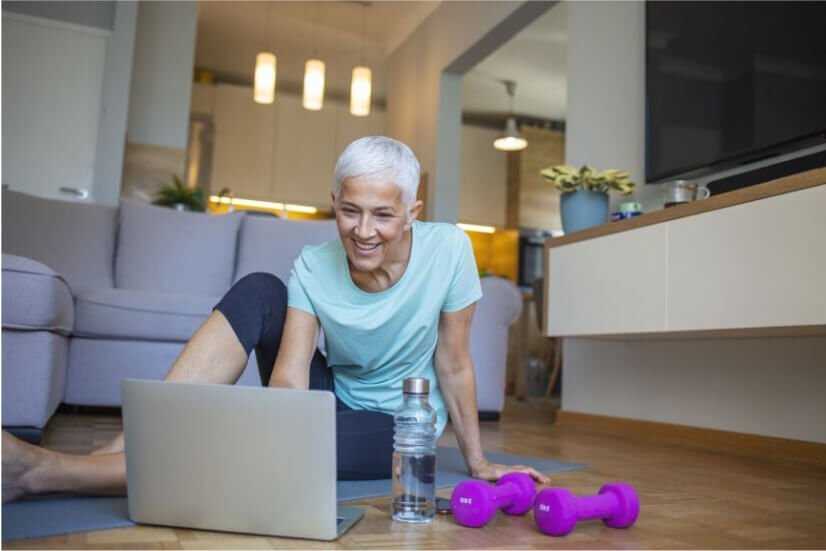Incontinence
Natural solutions for incontinence
by Molicare March 15, 2022

Is your quality of life affected by urinary incontinence? Medications and surgery are not the only treatments. Studies show that, for many incontinence sufferers, natural interventions can make a big difference in alleviating symptoms. Here are five of the most successful natural options you can try. And in the meantime, the MoliCare® range of incontinence products can help you live life to the full.
Train your pelvic floor
The pelvic floor muscles control the flow of urine. When these muscles are damaged or weakened, it can lead to incontinence. Research has shown that if you are able to contract your pelvic floor, then practising clench and release exercises several times a day can benefit anyone with urinary incontinence.
To perform them, first identify which muscles you need to focus on by discovering which ones contract when you stop your urine mid-stream. With an empty bladder, sit or lie down, and concentrate on squeezing these muscles for around five seconds. Relax and repeat ten times. You should ideally aim to do sets at least three times a day.
Try acupuncture
Studies show acupuncture can result in significant improvements in reducing the amount and frequency of urine leakage. A course of treatment targeting specific points in the lower back is proven to be effective for a number of different types of incontinence, including stress incontinence, urge incontinence and night-time bedwetting1.
Train your bladder
The aim of bladder training is to tackle an overactive bladder by learning to put off the need to pee. The idea is to lengthen the amount of time between trips to the toilet by letting the urge to urinate pass before going – perhaps beginning with holding off for around ten minutes. The end goal is to urinate every two to four hours. Another approach to retraining your bladder is to schedule toilet trips, going to the toilet at pre-set times rather than according to the urge to go.
Make changes to your diet
Certain foods can irritate the bladder, including artificial sweeteners, citrus fruits, carbonated drinks, chocolate, alcohol, spicy food and tomatoes. You can trial which are a problem for you by excluding them from your diet, and then reintroducing them one at a time every few days.
There are also foods and supplements you can add to your diet to reduce symptoms. There is evidence that Vitamin D deficiency can lead to incontinence2 so ensure you are eating food rich in the vitamin. Magnesium, an important mineral for muscle and nerve function, has been shown to reduce bladder spasms. Good sources of magnesium include bananas, oily fish and spinach. Studies have also shown that pumpkin seeds are effective for urinary disorders. 3
Cut down on your caffeine
A known diuretic, the caffeine in your morning coffee can increase the amount of urine your body makes. It’s also known to stimulate the part of the brain that sends messages to your bladder. Try switching from coffee, tea and cola to caffeine-free fruit teas and other bladder-friendly drinks such as water, barley water and low-acidic fruit juices, such as apple and pear, preferably diluted.
The MoliCare incontinence range includes products suitable for all degrees and types of incontinence, tailored to ensure maximum comfort and security. To discover more about how MoliCare products can help you manage your incontinence go to our product finder.
Medical Advice Disclaimer / DISCLAIMER: This website does not provide medical advice
The information, including but not limited to, text, graphics, images, and other material contained on this website are for informational purposes only. No material on this site is intended to be a substitute for professional medical advice, diagnosis, or treatment. Always seek the advice of your physician or other qualified health care provider with any questions you may have regarding a medical condition or treatment and before undertaking a new health care regimen, and never disregard professional medical advice or delay in seeking it because of something you have read on this website.
References
1. Liu B, Liu Y, Qin Z, Zhou K, Xu H, He L, Li N, Su T, Sun J, Yue Z, Zang Z, Zhang W, Zhao J, Zhou Z, Liu L, Wu D, Wu J, Zhou J, Pang R, Wang Y, Liu J, Yu J, Liu Z. Electroacupuncture Versus Pelvic Floor Muscle Training Plus Solifenacin for Women With Mixed Urinary Incontinence: A Randomized Noninferiority Trial. Mayo Clin Proc. 2019 Jan;94(1):54-65. doi: 10.1016/j.mayocp.2018.07.021. PMID: 30611454.
2. Badalian, S. Obstetrics & Gynecology, April 2010; vol 115: pp 795-803.
3. Nishimura, M., Ohkawara, T., Sato, H., Takeda, H., & Nishihira, J. (2014). Pumpkin Seed Oil Extracted From Cucurbita maxima Improves Urinary Disorder in Human Overactive Bladder. Journal of traditional and complementary medicine, 4(1), 72–74. https://doi.org/10.4103/2225-4110.124355


